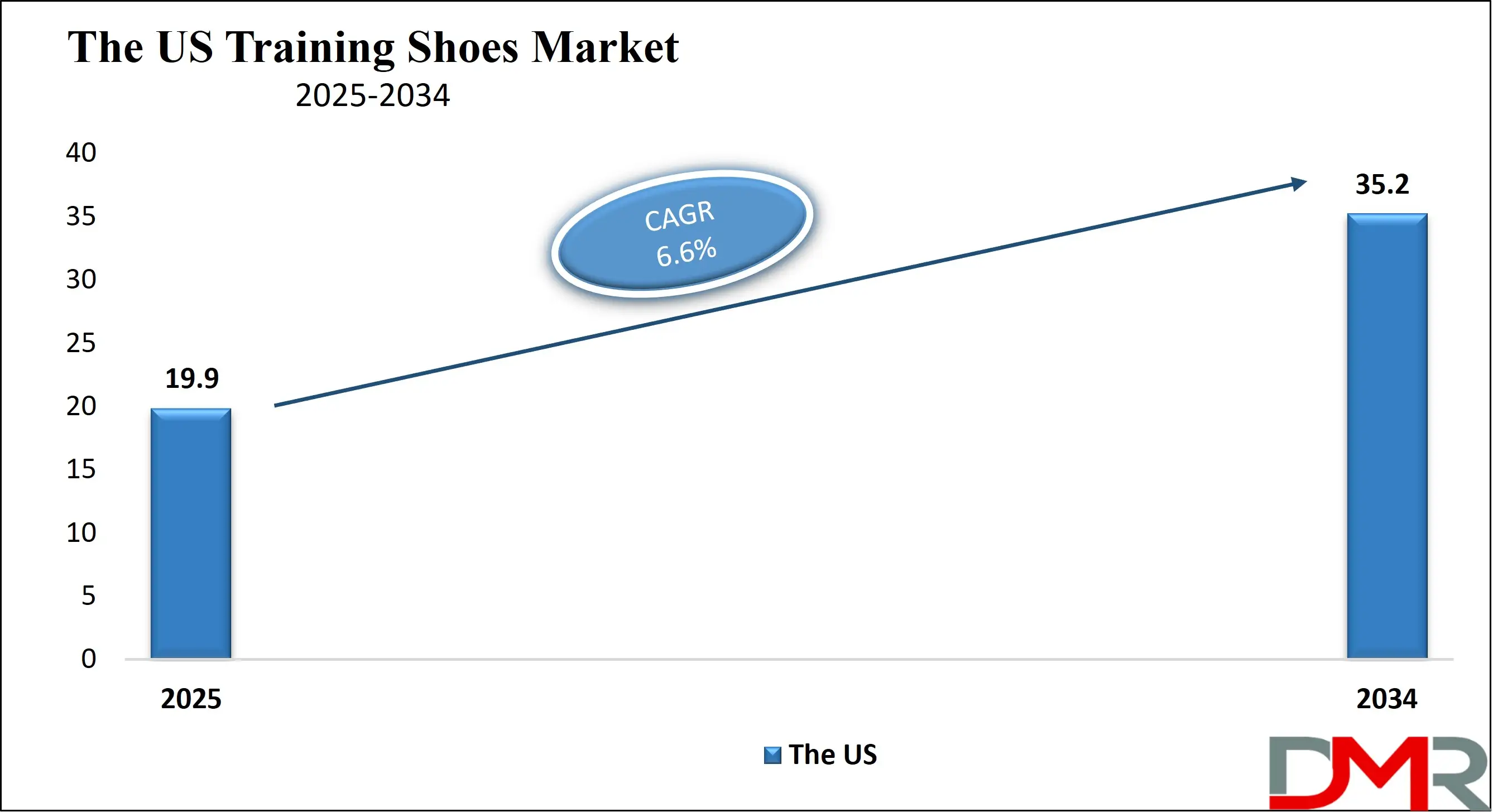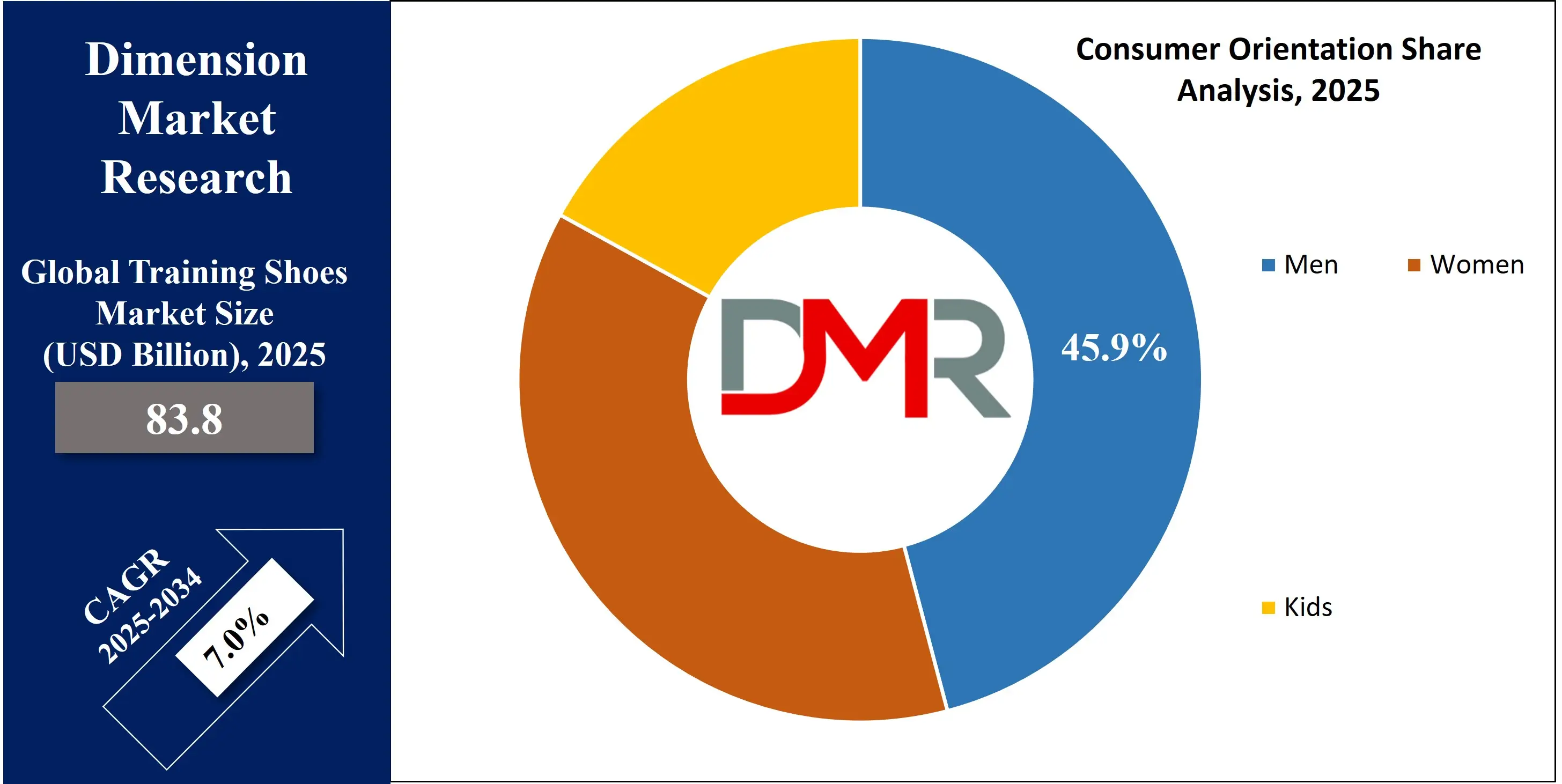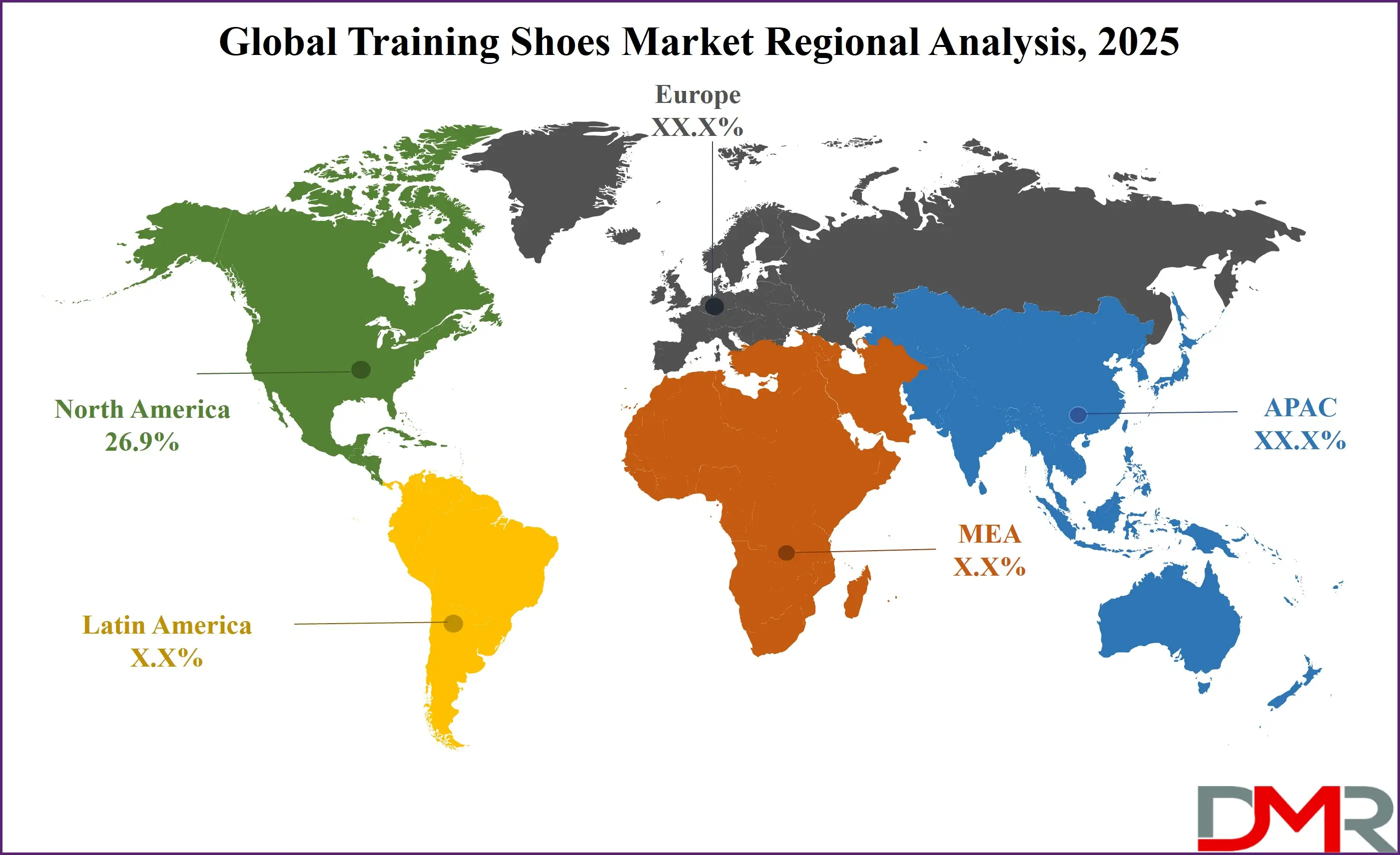As, the demand for training shoes has grown significantly in recent years, due to a rise in focus on health and fitness across the world, with many people adopting active lifestyles, joining gyms, or participating in home workouts, the requirement for versatile footwear has surged. The growth of fitness trends like high-intensity interval training (HIIT), CrossFit, and circuit training has further driven the popularity of training shoes. People want shoes that can adapt to multiple activities, making training shoes a practical and cost-effective choice. In addition, the global expansion of sportswear brands and e-commerce platforms has made these shoes more accessible than ever.
Further, trends in training shoe designs focuses on innovation, style, and sustainability. Brands are incorporating advanced materials like breathable mesh, lightweight foam cushioning, and durable outsoles to improve performance and comfort. Aesthetic appeal also plays a major role, as consumers primarily look for shoes that combine functionality with trendy designs. Sustainable production practices have gained momentum, with companies utilizing recycled materials and eco-friendly manufacturing processes. Customization options, like personalized colorways and fit adjustments, have also become popular, catering to individual preferences and needs.
Moreover, the recent pandemic had a notable impact on the training shoe market. As lockdowns and social distancing measures led to gym closures, many people transformed to home workouts and outdoor exercises, developing a spike in demand for versatile footwear. Virtual fitness programs and online workout communities also played a role in promoting the use of training shoes. Moreover, major sportswear brands have sponsored global fitness events & collaborated with athletes to market their products, boosting awareness and sales. Trade shows and product launches remain crucial in showcasing the latest innovations in the industry.
Further, rise in preference for all-in-one fitness solutions, where training shoes stand out as a practical option. Their adaptability saves consumers from purchasing multiple pairs of shoes for different activities. However, the importance of selecting the right training shoes cannot be overstated. Proper footwear helps prevent injuries, improve performance, and enhance comfort during workouts. Experts recommend choosing shoes that fit well, match the intended activities, and provide adequate support based on individual needs.

The future of training shoes looks promising, with ongoing development in technology and design. Smart shoes with integrated sensors to track performance metrics, like steps, calories burned, and movement patterns are likely to gain traction. The focus on sustainability will continue, with brands striving to minimize their environmental footprint. As fitness remains a global priority, the training shoe market is expected to expand further, driven by innovation and evolving consumer demands, which makes training shoes not only a practical choice for exercise but also a reflection of modern lifestyle trends.
The US Training Shoes Market
The US Training Shoes Market is projected to reach USD 19.9 billion in 2025 at a compound annual growth rate of 6.6% over its forecast period.

The US provides growth opportunities in the training shoes market due to a strong focus on fitness, wellness trends, and growth in participation in activities like running CrossFit, and gym workouts. The increase in consumer demand for comfortable, high-performance, and eco-friendly footwear, along with the growth of online retail, provides significant potential for brands to expand their presence and reach a broader audience.
Further, the market is driven by increasing fitness awareness, a strong sports culture, and a growing demand for versatile, high-performance footwear. However, market growth experiences challenges due to intense competition, high price sensitivity, and consumer preference for specialized shoes over multi-use options, which may limit the broader adoption of training shoes.
Key Takeaways
- Market Growth: The Training Shoes Market size is expected to grow by USD 64.5 billion, at a CAGR of 7.0% during the forecasted period of 2026 to 2034.
- By Outer Material: The mesh segment is anticipated to get the majority share of the Training Shoes Market in 2025.
- By Closure Type: Lace-up segment are expected to be leading the market in 2025
- By Consumer Orientation: The men segment is expected to get the largest revenue share in 2025 in the Training Shoes Market.
- Regional Insight: North America is expected to hold a 26.9% share of revenue in the Global Training Shoes Market in 2025.
- Use Cases: Some of the use cases of Training Shoes include gym workout, short runs & cardio, and more.
Training Shoes Market Use Cases
- Gym Workouts: Ideal for weightlifting, treadmill use, & fitness classes, providing stability, cushioning, and flexibility for a variety of exercises.
- HIIT and Cross-Training: Designed for high-intensity interval training, circuit workouts, and CrossFit, providing support for dynamic movements like jumps, lunges, and lateral shifts.
- Short Runs and Cardio: Suitable for light jogging, sprints, or other moderate cardio activities with sufficient cushioning for impact absorption.
- Outdoor and Home Workouts: Versatile for home exercises, yoga, or outdoor training, ensuring comfort and grip on different surfaces.
Stats & Facts
- According to UK Fitness, 76% of UK residents aspire to be fit and healthy, but 65% feel they don’t look after their health as much as they should, showing a slight 1% improvement from last year.
- Also, mental health and physical fitness remain key priorities in the UK, with 34% of people wanting to improve their mental health and 34% focusing on cardiovascular fitness, followed by 33% aiming to get stronger.
- As per Fitbudd, 30% of adults in the USA now engage in daily physical activities, a rise driven by growing health awareness. Younger adults (18-34) lead with 40% participating, followed by 35% of middle-aged adults (35-54), and 25% of seniors (55+), reflecting a positive trend across all demographics.
- Also, fitness apps and wearables are transforming how people exercise in the USA, with 45% of active adults using apps to track progress and 35% relying on devices like smartwatches to monitor health metrics.
- According to the International Health, Racquet & Sportsclub Association (IHRSA), gym memberships in the USA reached a record 64.2 million in 2023, reflecting robust growth in the gym industry.
- Further, the Sports & Fitness Industry Association (SFIA) reported that running and jogging remain favorite activities among fitness enthusiasts, with 60 million Americans participating annually, while yoga and Pilates are seeing rising popularity, with over 20 million practicing yoga regularly.
- Also, as per The National Sporting Goods Association (NSGA) reports, basketball and swimming rank among the most popular sports in the USA and are enjoyed recreationally and competitively by millions.
Training Shoes Market Dynamic
Driving Factors
Rising Fitness AwarenessThe increase in emphasis on health and wellness globally has led to higher participation in physical activities like gym workouts, HIIT, and home-based fitness programs, which has driven demand for versatile footwear like training shoes that look into multiple exercise needs, making them a popular choice for fitness enthusiasts across age groups
Technological Advancements and Innovation
Constant innovation in training shoe design, like lightweight materials, better cushioning, and better lateral support, has better performance and comfort. In addition, the integration of sustainability features and smart technology has attracted eco-conscious and tech-savvy consumers, further driving market growth.
Restraints
High Competition and Substitutes
The training shoe market experiences intense competition from specialized footwear like running or weightlifting shoes, which are popular among niche user groups. In addition, the presence of numerous brands offering similar features at varying price points creates challenges for market differentiation and brand loyalty.
Price Sensitivity and Affordability
Premium training shoes with advanced features often come with high price tags, making them less accessible to price-sensitive consumers, which limits market growth, mainly in developing regions where affordability and basic functionality take precedence over brand and innovation.
Opportunities
Expansion in Emerging Markets
Growing fitness awareness and a rise in disposable income in developing countries present many opportunities for training shoe brands. As more people in these regions adopt active lifestyles, the need for affordable and versatile athletic footwear is expected to rise, creating a large untapped market for expansion.
Adoption of Smart and Sustainable Technology
The integration of smart technologies, like fitness tracking sensors, and the use of eco-friendly materials in shoe production open new avenues for innovation. These features appeal to environmentally conscious & tech-savvy consumers, and provide brands an opportunity to differentiate their products and capture emerging consumer trends.
Trends
Sustainability and Eco-Friendly Designs
Consumers are mainly prioritizing sustainability, prompting brands to use recycled materials, biodegradable components, and eco-friendly manufacturing processes. Companies like Adidas and Nike are introducing "green" training shoe collections, aligning with global environmental goals and attracting eco-conscious buyers.
Customization and Personalization
Training shoes now offer customization options, allowing consumers to choose colors, designs, and even tailored fits, which cater to individual preferences and improve customer engagement, making personalized footwear a growing segment in the market.
Research Scope and Analysis
By Closure Type
Lace-up closures are expected to lead the training shoes market in 2025 by offering a reliable and customizable fit, which allows users to adjust the tightness of their shoes based on their comfort and activity, ensuring proper assistance during workouts. Lace-up designs provide better stability, mainly for lateral movements and high-intensity exercises, minimizing the risk of injury. They are versatile & suitable for various foot shapes, making them a popular choice among fitness enthusiasts. Additionally, lace-up closures are durable and long-lasting in comparison to alternatives like Velcro, further boosting their appeal. With many brands integrating lace-up closures with modern aesthetics, this classic design continues to attract consumers, driving demand in the training shoes market.
Further, Slip-on closures are anticipated to significantly in the coming years by offering convenience & ease of use. These shoes remove the need for laces, allowing users to quickly put them on or take them off, making them ideal for people with busy lifestyles. Slip-on designs mostly feature stretchy materials for a snug, comfortable fit, appealing to those looking for a hassle-free experience. Their stylish, minimalist look further attracts consumers, boosting their popularity in the growing training shoe market.
By Outer Material
Mesh as an outer material plays an important role in the growth of the training shoe market and is expected to significantly contribute by offering breathability, comfort, and lightweight performance. Its breathable design helps keep feet cool and dry during intense workouts, important for user comfort and preventing moisture buildup. Mesh is also flexible, allowing the shoes to adapt to the shape and movement of the foot, providing a better fit and mobility.
In addition, its lightweight nature reduces the overall weight of the shoe, making it ideal for activities that require speed & agility. Many brands use mesh for its modern, sporty look, which appeals to style-conscious consumers. The combination of functionality & aesthetics makes mesh a popular choice, driving demand for training shoes with this material.
Further, synthetic materials are important in the growth of the training shoe market due to their durability, lightweight nature, and affordability. It provides strong support and resistance to wear and tear, making it suitable for intense workouts. Synthetic materials are easy to clean and maintain and can be shaped into modern, stylish designs. Their affordability also makes training shoes with synthetic uppers accessible to a wide range of consumers.
By Cushioning Type
In terms of cushioning type, foam cushioning is projected to play a vital role in the growth of the training shoe market in the coming years by providing superior comfort, impact absorption, and support, which helps reduce the strain on joints and muscles during high-impact activities, like running, jumping, or weightlifting, making workouts more comfortable and less likely to cause injury. Foam is lightweight & flexible, adapting to the shape of the foot for a personalized fit. Its ability to provide energy return boosts performance by providing a responsive feel during training sessions. With developments in foam technology, like memory foam and EVA (Ethylene Vinyl Acetate), training shoes in present times offer better comfort, breathability, and durability. These benefits make foam cushioning a popular choice, driving demand and growth in the training shoe market.
Further, carbon plates are being highly used in training shoes for their ability to provide extra stability and energy return. These plates help distribute pressure evenly across the foot during intense activities, minimizing fatigue & enhancing performance. By adding stiffness, they support better propulsion, making movements more efficient, mainly in high-impact exercises. The use of carbon plates in shoes has gained attention for offering a responsive, lightweight feel, which contributes to the growing demand for high-performance training footwear.
By Consumer Orientation
In 2025, men's segment is set to lead the training shoes market in terms of revenue share, driven by growth in participation in fitness activities like gym workouts, sports, and running. Men are mostly focused on performance, looking for shoes that provide durability, comfort, and support for various activities. As more men look for active lifestyles, the demand for versatile training shoes has grown. In addition, brands tailor their designs to meet the specific needs of male consumers, offering styles that combine functionality with trendy aesthetics. With the growth of sports and fitness culture, men are also becoming more conscious of the latest technologies in footwear, like better cushioning, support, and lightweight materials.

In addition, the women's segment is projected to grow significantly due to the rise in participation in fitness activities like yoga, running, and strength training. Women often look for stylish, comfortable, and supportive shoes that match their active lifestyles. Brands are looking to this demand by providing trendy designs, enhanced cushioning, and lightweight materials. As fitness awareness grows, women continue to be a significant consumer group in the training shoe market.
By Sales Channel
Based on sales channels Multi-brand stores will get the majority revenue share in the training shoe market in 2025 by providing consumers with various brands and styles in one location. These stores provide the convenience of comparing different shoe options, making it easier for customers to choose the best fit for their needs. By stocking products from multiple well-known brands, multi-brand stores appeal to a large customer base and improve the shopping experience. Customers benefit from the opportunity to explore various models, features, and price ranges, all under one roof. In addition, these stores often provide sales, promotions, and loyalty programs, further driving purchases. The accessibility and diverse selection of multi-brand stores make them a vital sales channel, contributing to the overall growth of the training shoe market as more consumers look for a convenient and complete shopping experience.
Further, online retailers have become a major sales channel in the growth of the training shoe market, offering convenience, a wider selection, and competitive pricing. Consumers can easily compare brands, read reviews, and purchase from the comfort of their homes. With fast delivery and hassle-free return policies, online shopping has made training shoes more accessible, driving significant growth in the market.
The Training Shoes Market Report is segmented on the basis of the following
By Closure Type
- Lace Up
- Elastic
- Slip-on
- Velcro
- Others
By Outer Material
- Leather
- Mesh
- Synthetic Material
- Others
By Cushioning Type
- Gel
- Foam
- Air
- Carbon Plate
By Consumer Orientation
By Sales Channel
- Multi-brand Stores
- Independent Small Stores
- Online Retailers
- Others
Regional Analysis
In 2025, North America will be leading the training shoes market, with a share of 26.9% due to its strong fitness culture, high disposable incomes, and advanced sports industry. With various fitness enthusiasts, gymgoers, and athletes, the need for versatile training footwear has grown in recent years. The region's consumers prioritize comfort, performance, and style, driving brands to innovate and provide high-quality shoes tailored to various workouts. In addition, North American consumers are highly engaged in online shopping, making it easier to access a variety of training shoe options. T

he presence of major sportswear brands like Nike, Adidas, and Under Armour in the region has further strengthened the market. Health-conscious trends, such as the growing popularity of CrossFit, running, and home workouts, have also contributed to an increased demand for training shoes.
Europe, on the other hand, is also expected to have a significant market share, driven by a major focus on health and fitness across the region. Consumers look for high-performance footwear for sports, gym workouts, and outdoor activities. With an major preference for sustainable products and innovation, Europe’s demand for quality training shoes continues to rise, contributing to the market’s expansion.
Also, Asia Pacific is a rapidly growing region for the training shoe market due to rising disposable incomes, urbanization, and growth in interest in fitness. As more people have active lifestyles, demand for versatile, comfortable footwear has surged. The region also sees significant growth in online retail and brand awareness, making the Asia Pacific an important contributor to the global expansion of the training shoe market.
By Region
North America
Europe
- Germany
- The U.K.
- France
- Italy
- Russia
- Spain
- Benelux
- Nordic
- Rest of Europe
Asia-Pacific
- China
- Japan
- South Korea
- India
- ANZ
- ASEAN
- Rest of Asia-Pacific
Latin America
- Brazil
- Mexico
- Argentina
- Colombia
- Rest of Latin America
Middle East & Africa
- Saudi Arabia
- UAE
- South Africa
- Israel
- Egypt
- Rest of MEA
Competitive Landscape
The competitive landscape of the training shoes market is highly dynamic, with various brands providing a variety of footwear designed for many fitness activities. Key players aim for innovation, with developments in materials, cushioning, and design to meet the needs of active consumers. Pricing, product quality, and brand loyalty are major factors influencing competition. In addition, companies are majorly incorporating sustainable practices and technology, like smart features, to attract eco-conscious and tech-savvy buyers, further intensifying market rivalry.
Some of the prominent players in the global Training Shoes are
- Nike
- Puma
- Adidas
- Fila
- Sketchers
- Reebok
- Asics
- Under Armour
- New Balance
- Brooks
- Other Key Players
Recent Developments
- In December 2024, Reebok launched the latest iteration of its award-winning Nano franchise, the Nano X5 Training Shoes, as the new Nano X5 elevates comfort to new heights without compromising on performance. Introducing a new DUALRESPONSE Midsole and Decoupled Metasplit Outsole that improves performance support to cater to a range of movements from heavy lifts to increased flexibility and tunability. Plus, a Performance Comfort Collar that will allow her to remain locked in and focused on her workout.
- In September 2024, Adidas launched Adizero Adios Pro 4 and Adizero Evo SL ahead of the fall marathon season. The race-ready Adios Pro 4 is designed for peak performance, while the Evo SL, a fast-paced training shoe inspired by the record-breaking Adizero Adios Pro Evo 1, provides athletes optimal support during race preparation. These new releases are designed to help athletes achieve top performance, both on race day and in training.
- In July 2024, Reebok announced a latest addition to its Nano Training Shoe franchise, the Nano Gym, which is a training shoe built to be accessible for all, the Nano Gym has the look and feel of a running shoe but is built with the premium performance support of the Nano training shoe. Whether it be a boutique fitness class or a treadmill-heavy training session at the gym, the Nano Gym can do it all.
- In June 2024, Adidas launched its latest high-performance footwear iteration, Dropset 3. Designed mainly for the demands of weight-based exercises, providing better stability, breathability, durability, and grip to help athletes go from strength to strength with lifts, sets and reps.